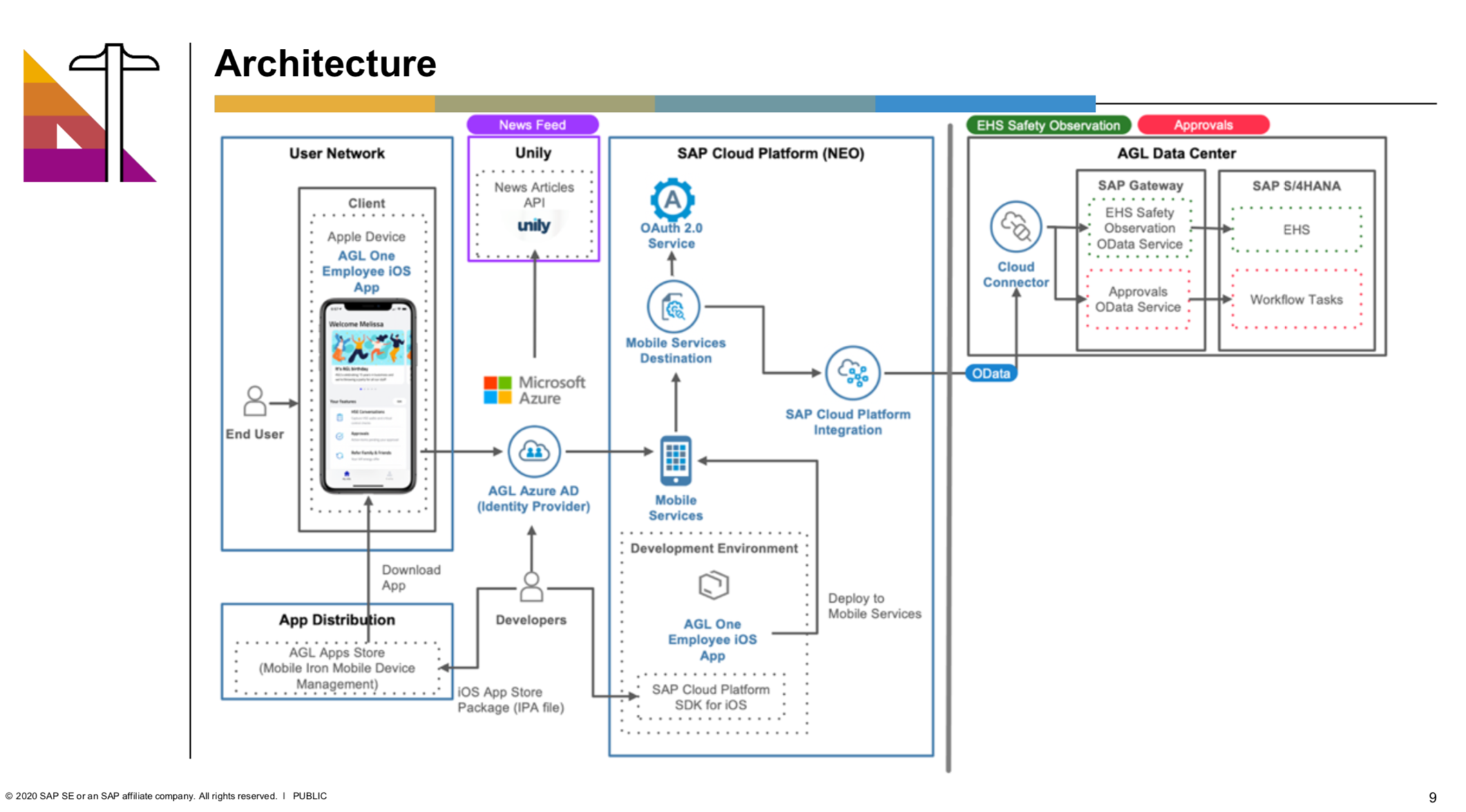AGL is in soft-launch for an iOS app that provides a single window through which staff can access over 300-plus IT applications to complete a range of mostly administrative tasks.

The app, called AGL One, was created with Bourne Digital, SAP and Apple, and builds on an earlier project codenamed PT3 that brought all of AGL's operations onto a single core SAP system.
AGL IT transformation manager Joy Marrocco told a recent webinar the completion of PT3 enabled the company “to have a look at what we were doing around digitally enabling the ways our people were working”.
The transformational benefits of moving to a consolidated SAP backend brought some mobility benefits for AGL staff, but also an opportunity for deeper digital change.
“When we launched PT3 and the SAP platform, it really opened a big world for us around mobility for our people and what we could do to digitally enable the ways of working for them,” Marrocco said. “But we didnt know how to do that.”
The utility set up an ‘employee experience centre’ and interviewed as many staff as possible to understand their challenges and “pain points”, and how they envisioned benefitting from digital ways of working.
“We mapped out the employee journey, and underneath every key element of that journey was a whole raft of use cases and pain points that we identified for our people,” Marrocco said.
“We have then worked across AGL to ensure that people from our HR teams, our process teams and policy teams, as well as us within the IT and digital teams, are all working together to resolve those pain points to make this employee experience journey better over time.”
The employee experience centre acts as a central site where people and digital technology mix. Staff from different areas can see what their colleagues in other business units are working on, and try these technologies out.
Through this, it is also apparent which technologies and experiences that staff gravitate to or find easy-to-use, which may help inform future decisions and directions.
“When talking to our people and doing those interviews, people struggled to visualise what that next world could be for them,” Marrocco said.
“In the digital space ... sometimes people don’t know what they want until they’ve seen a great example of something, and then they can think about how they would apply that to their world and how that might make their day-to-day easier.”
Enter AGL One
Out of the interviews and experience centre came a “massive program of work” led by Marrocco, which includes the AGL One iOS app.
“The interviews that we did with our people identified that we had too many tools within our environment, and that our people were unsure which tool to use when, or that [some tools] even existed at all,” Marrocco said.
“We wanted consolidation, simplification and a really simple UX for people so that for tasks that staff needed to do on occasion, they didn’t have to re-teach themselves how to use a whole system in order to perform them but rather had a quick and easy way to push those things through.”
From this feedback, the AGL One app was born.
“It is the one app that brings together all of your necessary tools into one easy-to-use platform that will allow you to login with a single sign-on and navigate out to all of those tools in our environment,” Marrocco said.
In a slide deck, AGL said that the app “combines over 300 different applications in the AGL environment into one single interface.”
“The app requires only one main login to use, so even when employees want to switch back and forth between apps, they do not have to re-login and remember different passwords every time,” the deck states.
“Once signed in, the UX itself is very accessible to the average employee, so they don’t have to know specific tool names or apps in order to use them.
“And, while the app is not meant to replace what staff do on their desktops, its built-in capabilities prioritise tasks that are easy to do on-the-go, such as administrative tasks and approvals.
“This reduces cycle time on tasks that are often put off and need to be followed up on, making employees’ work days more productive and efficient all around.”
The ‘systems’ that AGL One provides a window into comprise a mix of other native iOS apps, weblinks and third-party applications such as Workday.
Marrocco explained: “We try not to use names of systems but rather names of tasks that you’re trying to perform to make it really easy for you to understand which part of the app you need to go into to perform a particular task you’re trying to do at the time.
“Some of those apps/features have been built as iOS native, so they’re within the app talking directly to those systems; some of them are weblinks that just take you straight out but give you a nice and easy authentication path to make it quick and easy for you to access those tools that most of our people didn’t even know existed before we built this [AGL One] app.”
The ability to do single sign-on for all of these different systems has proven to be one of the most challenging elements of the build so far.
“For a whole range of reasons, there are a lot of tools that are congregating in that app and they all have slightly different authentication processes,” Marrocco said.
“We have been really diligent around protecting that user experience and what that single sign-on needs to look like so you can log into the app, and go in and authenticate, and then as you navigate away from the app into other tools in our environment that you don’t need to re-authenticate.
“We’ve had to look at every [enterprise] app and the authentication path for it and ensure we’re providing as frictionless a process for our people as humanly possible.
“We’ve certainly observed with our user groups and test groups that the minute there’s friction in the process they will give up and stop using the [AGL One] app.”
Authentication for the app is ultimately handled through Azure Active Directory; much of the rest of the architecture is handled by SAP cloud services hosted within the vendor’s enterprise PaaS called Neo.
Part of the challenge building AGL One, Marrocco said, was that the team was unable to find a similar example anywhere in the world that it could at least partially lean on or replicate.
“We really struggled to find a really good example of this worldwide where people had done something like this before and there was a bit of a pattern for us to copy,” she said.
“So the other element of this - and the biggest challenge that we had - is this is uncharted territory.
“People had done snippets of what we’ve pulled together but no one had done this end-to-end journey mapping and then complementing it with a digital tool from an employee sense.”
She noted that some of the early pains of the project had since subsided and that the team was now able to add system access and new features much faster than even “a few months ago”.
In addition to aggregating access to all enterprise systems, AGL One offers other types of information, including intranet, a ‘family and friends’ function to help staff answer AGL-related questions in social situations, a desk locator, a health and safety issues logger and - soon - a way to handle internal approvals of purchase orders or leave requests on-the-fly.
“This is really exciting, it’s in its final stages of testing and is about to launch,” Marrocco said.
“Approvals for us is really around aggregating a number of approvals that our leaders need to do for our people across our entire network, bringing them all into one checklist and making it really fast and easy for them to remove bottlenecks for their people by approving requests as and when they’re required as they go about their day.”
AGL One is currently under soft launch.
“We decided for a whole range of reasons to do a soft launch at the moment with the AGL One app, rather than doing blanket comms to everyone telling them it’s there and asking them to download it,” Marrocco said.
“We’re actually relating key features of the app to key employee events and supporting that with comms and training around how to access the app and what it can do for you.
“A good example of an employee event is taking Christmas leave or booking leave. You can do it through our app by going into our system Workday.
“So rather than doing blanket messaging around ‘adopt the app’, we’re doing messaging around specific features that the app can help you deliver but framing those through employee event lenses.”























